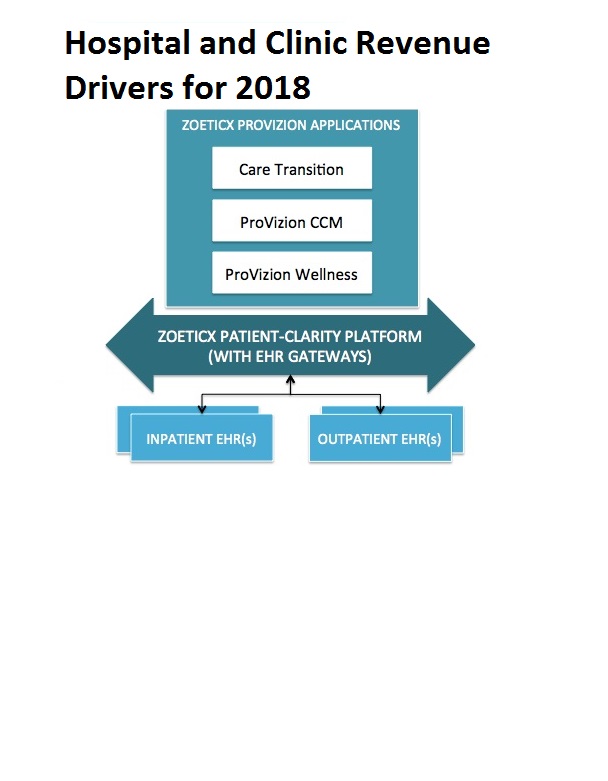By Donald Voltz, MD, Aultman Hospital, Department of Anesthesiology, Medical Director of the Main Operating Room, Assistant Professor of Anesthesiology, Case Western Reserve University and Northeast Ohio Medical University. Board-certified in anesthesiology and clinical informatics, Dr. Voltz is a researcher, medical educator, and entrepreneur. With more than 15 years of experience in healthcare, Dr. Voltz has been involved with many facets of medicine. He has performed basic science and clinical research and has experience in the translation of ideas into viable medical systems and devices.
One ageless trend emerging for 2018 is the quest of hospitals, larger carriers and clinics to identify new revenue streams; not just managing revenue cycles, but creating them. The healthcare industry is now looking at revenue which can be generated through the interoperability of Annual Wellness Visits (AWV), chronic care and service care transitions between physical and behavioral health services. Hospital systems and other healthcare facilities that can connect these services with technologies such as bi-directional information flow will benefit by offering these services and creating a new profit centers of revenue through reimbursements by CMS and private insurers.
These types of market drivers are noted in The Global Healthcare Revenue Cycle Management (RCM) Software Market report for 2017-2021, issued a few months ago. The report predicts that the global Healthcare Revenue Cycle Management (RCM) Software market will grow at a CAGR of 4.50% during the period through 2021.
Healthcare service providers deploy automated systems to address RCM processes and to fill the payment gap that arises from the processes of medical billing and collections. However, the report points out IT applications such as hospital information system and EHR have outdated technology platforms that lack advanced functionalities needed to address RCM issues, causing hospitals and health systems to prefer to outsource these services due to the lack of interoperability between revenue cycle processes and workflows. This type of outsourcing drains hospital revenue.
Meanwhile, global business researcher Radiant Insights issued a study in November reporting that the healthcare information technology market will have growth through 2022 of close to 50 billion. Factors such as increasing focus on improving quality of care and clinical outcomes, rising need to reduce healthcare costs and minimize errors in medical facilities along with government support for healthcare IT solutions will drive the market. Increasing adoption of technologically advanced software solutions including EHR and EHR connectivity systems, e-prescribing and clinical trial management software and clinical decision support systems is helping to improve healthcare productivity.
The study also cited the growth of cloud computing in the healthcare industry is improving real-time communication and data exchange. Interoperable systems and cloud computing are integrating healthcare systems at a rapid pace and are identifying infectious diseases and tracking the incidence as well as occurrence rates of chronic diseases.
Radiant points to up and coming organizations such as Zoeticx, Inc., a provider of medical software, that has introduced a cloud app called ProVizion Wellness. This software can be beneficial for streamlining data integration for Annual Wellness Visits (AWV) by offering interoperability through bi-directional data flow. Hospitals and other healthcare facilities are benefiting by providing this service through private and government insurers. This system provides management capabilities for supporting tracking ability on population progress for AWVs. The report also mentioned prominent players operating in the healthcare information technology (IT) market include 3M Health Information Systems, Lexmark Healthcare, Conifer Health Solutions, and CSI Healthcare.
The Chemistry of Linking Unrelated Hospital IT Landscapes to Revenue
As the hospital revenue trend for 2018 looks promising, we are still facing the same old interoperability issues despite the advances in technology pointed out in the previously mentioned research. What can hospitals and clinics do to be a revenue leader? As we move into 2018, it might be a good time to examine what is necessary to solve a complex problem like the ability of hospitals to link interoperability and the benefits that arise from adopting tools, technologies and concepts from unrelated landscapes.
When we look at the value generated in healthcare, we remain enamored with acute care administration to address patients’ concerns with a new illness or exacerbation of a chronic condition. One of the stated goals of widespread EHR adoption was to assist in this aspect of care. EHRs are being used to capture patient data as well as to label and extract detailed metrics in an attempt to quantify the amount and quality of the care delivered, irrespective of the geographic and temporal boundaries of where the data was captured. The design of EHR’s is to allow for capture and subsequent analysis and billing for the care delivered.
However, the value of health IT lies in the robustness of applications. This might seem obvious since most of the technology we have direct experience with relies on the applications which drive value such as cloud based assets. For hospitals, investing in an application seems more prudent then investing in a protocol. However, by looking at the problems faced in healthcare, changing the perspective of the problem from an application-centric one to that of a protocol-centric view brings new revenue possibilities.
Protocols do exist in EHR’s, but instead of being the major component, they are accessories to help ‘glue’ things together, but what happens when hospital CIO’s invert the focus away from the application doing most of the work, to the protocol? With this focus, hospitals have the potential to increase value while reducing the overhead on application maintenance and expansion.
Teaching Old Data New Tricks
There are two driving principles to a protocol-centric solution; remove the data from the application and place it in a distributed, shareable container. With the separation of data from the application, data sequestration and dependencies are removed which reduces the barriers to entry and the development of novel, innovative and quality products. This separation also allows for greater flexibility and an ease of switching when an application fails to provide the necessary functionality and is deemed inadequate or risky for use.
Currently, the cost of maintenance and improvements to existing applications adds a burden to many healthcare administrators, with little justification on an increase in revenue or value that such enhancements might bring. It is almost impossible to consider switching to another application, when one fails to meet the needs and becomes too costly to continue to maintain. Not to mention, the expense, frustration and challenges to migrate the already contained data into the new system.
These are all serious considerations for many hospital CEO’s, CFO’s, CIO’s and physician-run practices. All of these issues become much less costly and easier to implement when the application-centric solution moves to a protocol-centric one.
When protocols have free access to the underlying data and the transactions that lead to the data or are involved with access and interpretation of the data in the course of care delivery, healthcare facilities twist the ecosystem from a competing one to one where non-cooperative or geographically separated healthcare systems are able to interoperate and use the data when the solutions are built upon identical open protocols. This changes the forces in the market, away from added expenses, into reduced costs, less duplication, and the ability to design and implement innovative new products and services that radically change the way healthcare is delivered and the value and benefits obtained by the patients and the payers.
Applications Driving Revenue in 2018
From the perspective of hospital administrators and providers, the goal is to capture relevant patient information and ascribe meaning to the often disconnected pieces of data. It is not missed on healthcare professionals that productivity and revenue capture is an important component of the care delivery process. The adoption of technology in healthcare has added the additional burdens of ensuring that patient data has been captured and critically analyzed to ensure high quality, effective and efficient care. At the same time, the data needs to placed in a context that supports diagnostic and billing codes to complete the cycle of care delivery.
Most systems have not been designed to integrate the billing and care delivery workflows, necessitating healthcare professionals to bring the integration to these two aspects of care. Technology has the potential to bridge this divide, and as has been demonstrated by Zoeticx with the ProVizion solution, automating and integrating the revenue capture with the care delivery component, we can achieve the clinical and financial requirements without the use of ‘human-powered’ integration.
One of the grand issues raised and a major impetus for the widespread adoption and implementation of health IT surrounds high quality, cost effective delivery of healthcare to the masses. Technology has the potential to address this, when properly designed. The requirements for technology are to appreciate delivery from an abstract level, for the entire healthcare ecosystem while allowing for the solving of specific, context-dependent problems in the hospitals and clinics where the care is delivered.
Using the abstract perspective of protocols and applying this to the areas of the Annual Wellness Visit and chronic care management, clinics, hospitals and health system have been able to improve or create new revenue streams while healthcare professionals have gained enhanced performance by the automation of tasks that required manual and often cumbersome tasks to complete their workflow. Designing workflows that improve and integrate the care delivery while also meeting the quality, financial and billing metrics has been demonstrated by Zoeticx in the ever changing and complex health IT ecosystem.






































